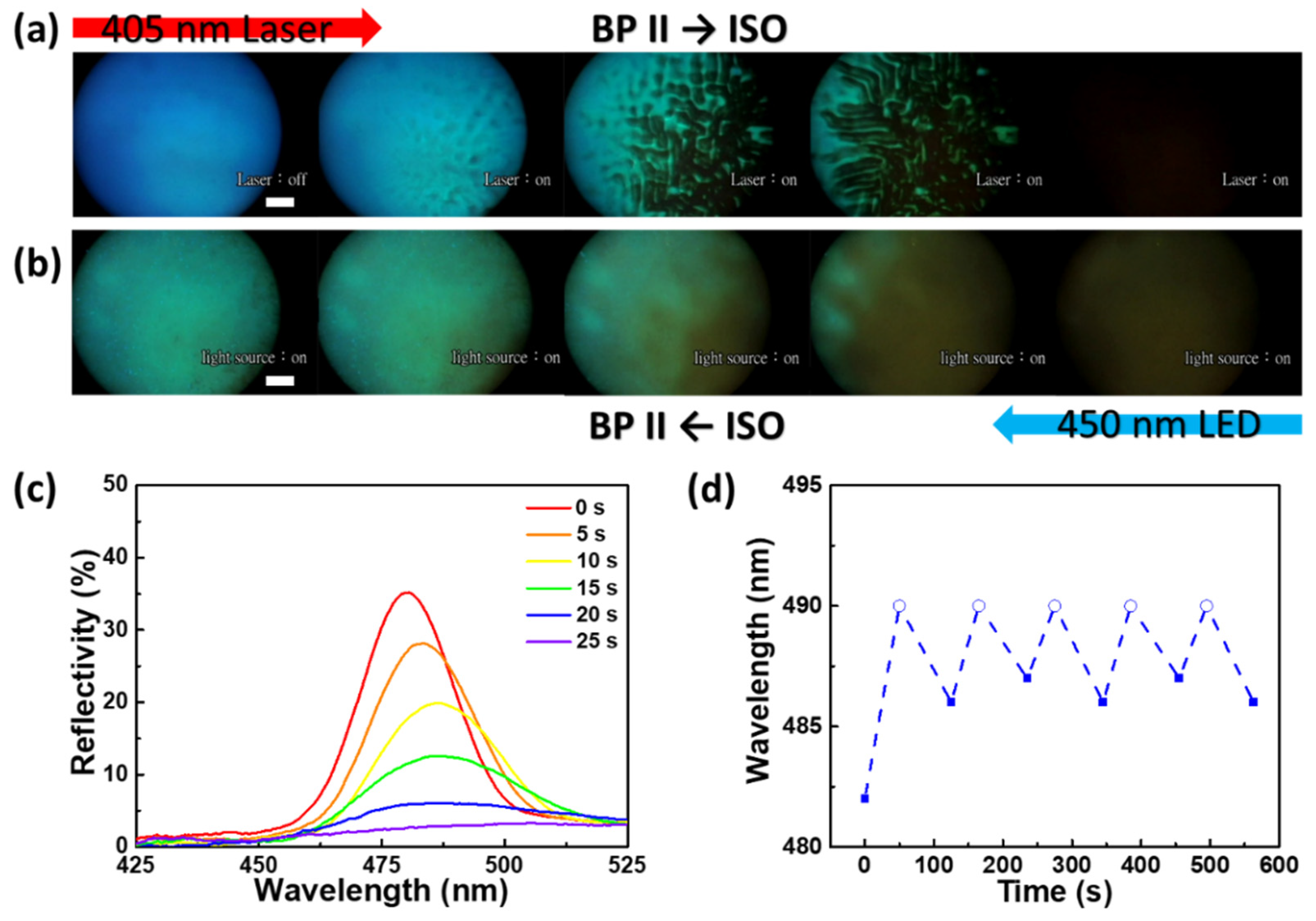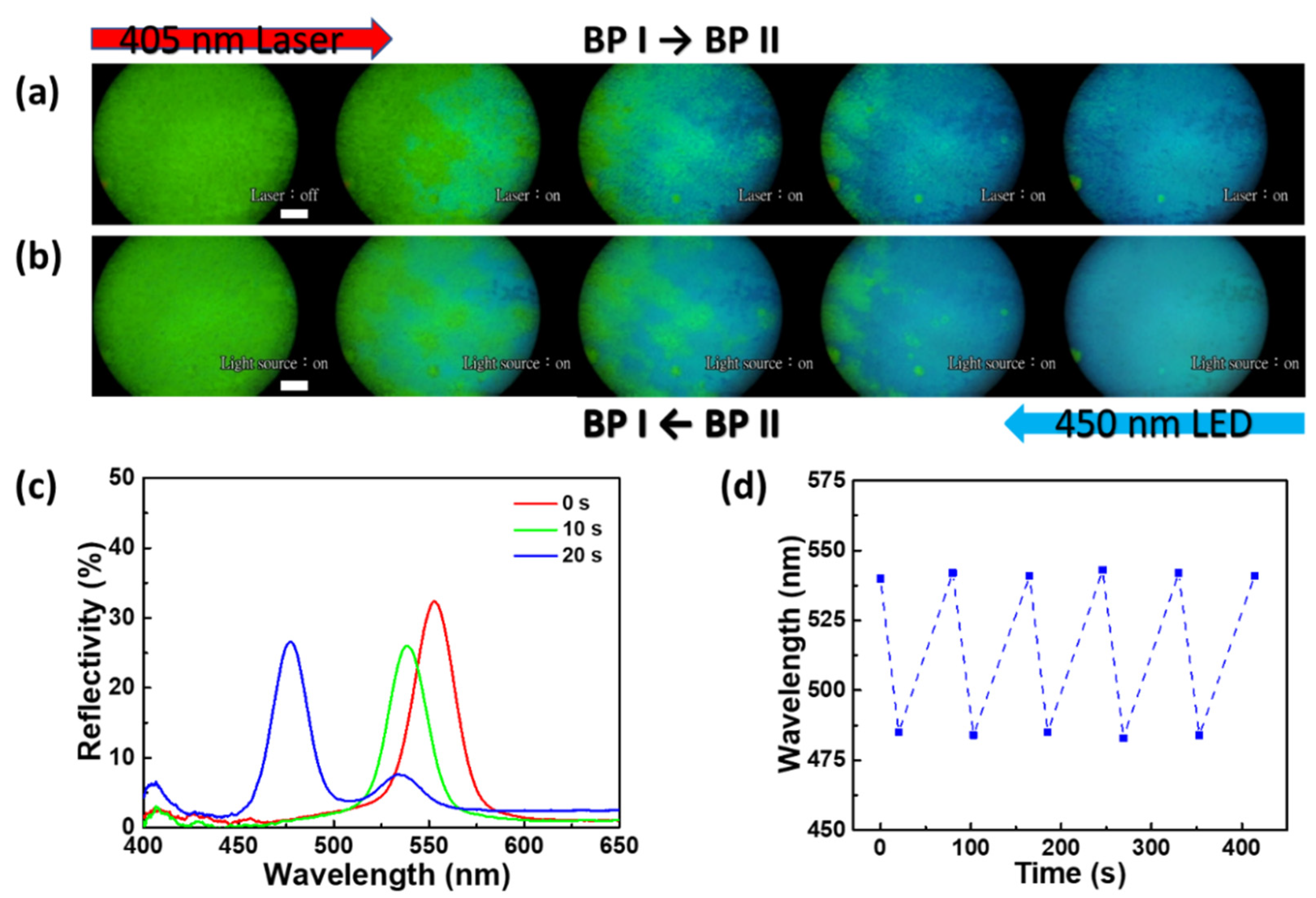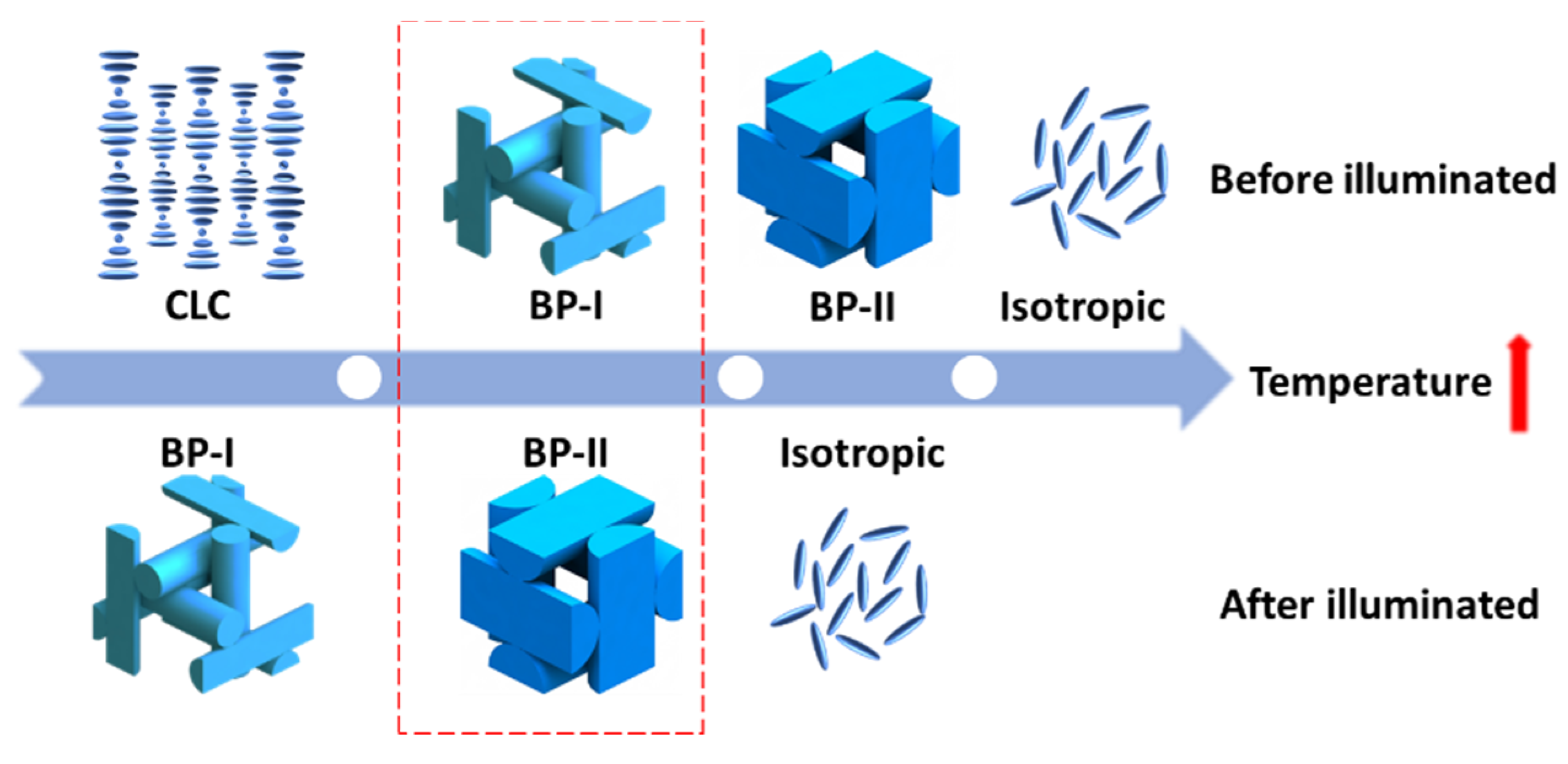All-Optically Controllable Photonic Crystals Based on Chiral-Azobenzene-Doped Blue Phase Liquid Crystals
Abstract
:1. Introduction
2. Materials and Methods
3. Results and Discussion
3.1. Basic Optical Properties of CA-BPLC Samples with and without Surface Alignment
3.2. Photo-Control of CA-BPLC Samples
4. Conclusions
Supplementary Materials
Author Contributions
Funding
Acknowledgments
Conflicts of Interest
References
- Huang, Y.; Hsiang, E.L.; Deng, M.Y.; Wu, S.T. Mini-LED, Micro-LED and OLED displays: Present status and future perspectives. Light Sci. Appl. 2020, 9, 105. [Google Scholar] [CrossRef] [PubMed]
- Chen, H.W.; Lee, J.H.; Lin, B.Y.; Chen, S.; Wu, S.T. Liquid crystal display and organic light-emitting diode display: Present status and future perspectives. Light Sci. Appl. 2018, 7, 17168. [Google Scholar] [CrossRef] [PubMed]
- Lin, J.D.; Wang, T.Y.; Mo, T.S.; Huang, S.Y.; Lee, C.R. Wide-band spatially tunable photonic bandgap in visible spectral range and laser based on a polymer stabilized blue phase. Sci. Rep. 2016, 6, 30407. [Google Scholar] [CrossRef] [PubMed] [Green Version]
- Lin, J.-D.; Huang, S.-Y.; Wang, H.-S.; Lin, S.-H.; Mo, T.-S.; Horng, C.-T.; Yeh, H.-C.; Chen, L.-J.; Lin, H.-L.; Lee, C.-R. Spatially tunable photonic bandgap of wide spectral range and lasing emission based on a blue phase wedge cell. Opt. Express 2014, 22, 29479–29492. [Google Scholar] [CrossRef]
- Lee, C.-R.; Lin, S.-H.; Guo, J.-W.; Lin, J.-D.; Lin, H.-L.; Zheng, Y.-C.; Ma, C.-L.; Horng, C.-T.; Sun, H.-Y.; Huang, S.-Y. Electrically and thermally controllable nanoparticle random laser in a well-aligned dye-doped liquid crystal cell. Opt. Mater. Express 2015, 5, 1469–1481. [Google Scholar] [CrossRef]
- Beeckman, J.; Neyts, K.; Vanbrabant, P.J.M. Liquid-crystal photonic applications. Opt. Eng. 2011, 50, 081202. [Google Scholar] [CrossRef] [Green Version]
- Chuang, C.H.; Lin, Y.C.; Chen, W.L.; Chen, Y.H.; Chen, Y.X.; Chen, C.M.; Shiu, H.W.; Chang, L.Y.; Chen, C.H.; Chen, C.H. Detecting trypsin at liquid crystal/aqueous interface by using surface-immobilized bovine serum albumin. Biosens. Bioelectron. 2016, 78, 213–220. [Google Scholar] [CrossRef]
- Chen, C.-H.; Lin, Y.-C.; Chang, H.-H.; Lee, A.S.-Y. Ligand-doped liquid crystal sensor system for detecting mercuric ion in aqueous solutions. Anal. Chem. 2015, 87, 4546–4551. [Google Scholar] [CrossRef]
- Ho, T.Y.; Lan, Y.H.; Huang, J.W.; Chang, J.J.; Chen, C.H. Using Diazotization reaction to develop portable liquid-crystal-based sensors for nitrite detection. ACS Omega 2020, 5, 11809–11816. [Google Scholar] [CrossRef]
- Kim, M.; Serra, F. Topological defect arrays in nematic liquid crystals assisted by polymeric pillar arrays: Effect of the geometry of pillars. Crystals 2020, 10, 314. [Google Scholar]
- Lavrentovich, O.D. Topological defects in dispersed words and worlds around liquid crystals, or liquid crystal drops. Liq. Cryst. 1998, 24, 117–126. [Google Scholar] [CrossRef]
- Etchegoin, P. Blue phases of cholesteric liquid crystals as thermotropic photonic crystals. Phys. Rev. E 2000, 62, 1435–1437. [Google Scholar] [CrossRef] [PubMed] [Green Version]
- Martínez-González, J.A.; Zhou, Y.; Rahimi, M.; Bukusoglu, E.; Abbott, N.L.; de Pablo, J.J. Blue-phase liquid crystal droplets. Proc. Natl. Acad. Sci. USA 2015, 112, 13195–13200. [Google Scholar] [CrossRef] [PubMed] [Green Version]
- Shamid, S.M.; Allender, D.W.; Selinger, J.V. Predicting a polar analog of chiral blue phases in liquid crystals. Phys. Rev. Lett. 2014, 113, 237801. [Google Scholar] [CrossRef]
- Huang, Y.; Chen, H.; Tan, G.; Tobata, H.; Yamamoto, S.-I.; Okabe, E.; Lan, Y.-F.; Tsai, C.-Y.; Wu, S.-T. Optimized blue-phase liquid crystal for field-sequential-color displays. Opt. Mater. Express 2017, 7, 641–650. [Google Scholar] [CrossRef]
- Lin, T.-H.; Chen, C.-W.; Li, Q. Self-organized 3D photonic superstructure: Blue phase liquid crystal. In Anisotropic Nanomaterials: Preparation, Properties, and Applications; Li, Q., Ed.; Springer International Publishing: Cham, Switzerland, 2015; pp. 337–378. [Google Scholar]
- Crooker, P.P. Plenary Lecture. The blue phases. A review of experiments. Liq. Cryst. 1989, 5, 751–775. [Google Scholar] [CrossRef]
- Guo, D.-Y.; Chen, C.-W.; Li, C.-C.; Jau, H.-C.; Lin, K.-H.; Feng, T.-M.; Wang, C.-T.; Bunning, T.J.; Khoo, I.C.; Lin, T.-H. Reconfiguration of three-dimensional liquid-crystalline photonic crystals by electrostriction. Nat. Mater. 2020, 19, 94–101. [Google Scholar] [CrossRef]
- Hisakado, Y.; Kikuchi, H.; Nagamura, T.; Kajiyama, T. Large Electro-optic kerr effect in polymer-stabilized liquid-crystalline blue phases. Adv. Mater. 2005, 17, 96–98. [Google Scholar] [CrossRef]
- Lu, S.-Y.; Chien, L.-C. Electrically switched color with polymer-stabilized blue-phase liquid crystals. Opt. Lett. 2010, 35, 562–564. [Google Scholar] [CrossRef]
- Rao, L.; Ge, Z.; Wu, S.-T.; Lee, S.H. Low voltage blue-phase liquid crystal displays. Appl. Phys. Lett. 2009, 95, 231101. [Google Scholar]
- Chanishvili, A.; Chilaya, G.; Petriashvili, G.; Collings, P.J. Trans-cis isomerization and the blue phases. Phys. Rev. E 2005, 71, 051705. [Google Scholar] [CrossRef] [PubMed] [Green Version]
- Liu, C.-K.; Huang, W.-L.; Fuh, A.Y.-G.; Cheng, K.-T. Binary cholesteric/blue-phase liquid crystal textures fabricated using phototunable chirality in azo chiral-doped cholesteric liquid crystals. J. Appl. Phys. 2012, 111, 103114. [Google Scholar] [CrossRef]
- Lin, T.H.; Li, Y.; Wang, C.T.; Jau, H.C.; Chen, C.W.; Li, C.C.; Bisoyi, H.K.; Bunning, T.J.; Li, Q. Red, green and blue reflections enabled in an optically tunable self-organized 3D cubic nanostructured thin film. Adv. Mater. 2013, 25, 5050–5054. [Google Scholar] [CrossRef] [PubMed]
- Lin, J.-D.; Lin, Y.-M.; Mo, T.-S.; Lee, C.-R. Photosensitive and all-optically fast-controllable photonic bandgap device and laser in a dye-doped blue phase with a low-concentration azobenzene liquid crystal. Opt. Express 2014, 22, 9171–9181. [Google Scholar] [CrossRef] [PubMed]
- Chen, L.-J.; Lin, J.-D.; Lee, C.-R. An optically stable and tunable quantum dot nanocrystal-embedded cholesteric liquid crystal composite laser. J. Mater. Chem. C 2014, 2, 4388–4394. [Google Scholar] [CrossRef]
- Demikhov, E.; Stegemeyer, H. Observation of a new metastable liquid-crystalline phase in supercooled blue phase systems. Liq. Cryst. 1991, 10, 869–873. [Google Scholar] [CrossRef]
- Jiang, S.-A.; Sun, W.-J.; Lin, S.-H.; Lin, J.-D.; Huang, C.-Y. Optical and electro-optic properties of polymer-stabilized blue phase liquid crystal cells with photoalignment layers. Opt. Express 2017, 25, 28179–28191. [Google Scholar] [CrossRef]
- Chen, P.-J.; Chen, M.; Ni, S.-Y.; Chen, H.-S.; Lin, Y.-H. Influence of alignment layers on crystal growth of polymer-stabilized blue phase liquid crystals. Opt. Mater. Express 2016, 6, 1003–1010. [Google Scholar] [CrossRef]
- Joshi, P.; Shang, X.; De Smet, J.; Islamai, E.; Cuypers, D.; Van Steenberge, G.; Van Vlierberghe, S.; Dubruel, P.; De Smet, H. On the effect of alignment layers on blue phase liquid crystals. Appl. Phys. Lett. 2015, 106, 101105. [Google Scholar] [CrossRef] [Green Version]
- Oton, E.; Netter, E.; Nakano, T.; Katayama, Y.D.; Inoue, F. Monodomain blue phase liquid crystal layers for phase modulation. Sci. Rep. 2017, 7, 44575. [Google Scholar] [CrossRef] [Green Version]
- Martinez-Gonzalez, J.A.; Li, X.; Sadati, M.; Zhou, Y.; Zhang, R.; Nealey, P.F.; de Pablo, J.J. Directed self-assembly of liquid crystalline blue-phases into ideal single-crystals. Nat. Commun. 2017, 8, 15854. [Google Scholar] [CrossRef] [PubMed] [Green Version]
- Manda, R.; Pagidi, S.; Heo, Y.; Lim, Y.J.; Kim, M.; Lee, S.H. Electrically tunable photonic band gap structure in monodomain blue-phase liquid crystals. NPG Asia Mater. 2020, 12, 42. [Google Scholar] [CrossRef]
- Yan, J.; Wu, S.-T.; Cheng, K.-L.; Shiu, J.-W. A full-color reflective display using polymer-stabilized blue phase liquid crystal. Appl. Phys. Lett. 2013, 102, 081102. [Google Scholar] [CrossRef] [Green Version]
- Chen, Y.; Wu, S.-T. Electric field-induced monodomain blue phase liquid crystals. Appl. Phys. Lett. 2013, 102, 171110. [Google Scholar] [CrossRef] [Green Version]
- Bukusoglu, E.; Martinez-Gonzalez, J.A.; Wang, X.; Zhou, Y.; de Pablo, J.J.; Abbott, N.L. Strain-induced alignment and phase behavior of blue phase liquid crystals confined to thin films. Soft Matter 2017, 13, 8999–9006. [Google Scholar] [CrossRef]
- Miller, R.J.; Gleeson, H.F. Lattice parameter measurements from the Kossel diagrams of the cubic liquid crystal blue phases. J. Phys. II France 1996, 6, 909–922. [Google Scholar] [CrossRef]
- Kikuchi, H. Liquid crystalline blue phases. Struct. Bond. 2008, 128, 99–117. [Google Scholar]
- Lin, J.-D.; Hsieh, M.-H.; Wei, G.-J.; Mo, T.-S.; Huang, S.-Y.; Lee, C.-R. Optically tunable/switchable omnidirectionally spherical microlaser based on a dye-doped cholesteric liquid crystal microdroplet with an azo-chiral dopant. Opt. Express 2013, 21, 15765–15776. [Google Scholar] [CrossRef]
- Natansohn, A.; Rochon, P. Photoinduced motions in azo-containing polymers. Chem. Rev. 2002, 102, 4139–4176. [Google Scholar] [CrossRef]
- Ringsdorf, H.; Schmidt, H.-W. Electro-optical effects of azo dye containing liquid crystalline copolymers. Makromol. Chem. 1984, 185, 1327–1334. [Google Scholar] [CrossRef]
- Wang, J.-R.; Lee, C.-R.; Lee, M.-R.; Fuh, A.Y.G. Photorefractive effect induced by polarization gratings in dye-doped liquid crystals. Opt. Lett. 2004, 29, 110–112. [Google Scholar] [CrossRef] [PubMed]
- Hsiao, Y.C.; Huang, K.C.; Lee, W. Photo-switchable chiral liquid crystal with optical tristability enabled by a photoresponsive azo-chiral dopant. Opt. Express 2017, 25, 2687–2693. [Google Scholar] [CrossRef] [PubMed] [Green Version]






© 2020 by the authors. Licensee MDPI, Basel, Switzerland. This article is an open access article distributed under the terms and conditions of the Creative Commons Attribution (CC BY) license (http://creativecommons.org/licenses/by/4.0/).
Share and Cite
Jiang, S.-A.; Wu, C.-H.; Mo, T.-S.; Huang, S.-Y.; Lin, J.-D.; Lee, C.-R. All-Optically Controllable Photonic Crystals Based on Chiral-Azobenzene-Doped Blue Phase Liquid Crystals. Crystals 2020, 10, 906. https://doi.org/10.3390/cryst10100906
Jiang S-A, Wu C-H, Mo T-S, Huang S-Y, Lin J-D, Lee C-R. All-Optically Controllable Photonic Crystals Based on Chiral-Azobenzene-Doped Blue Phase Liquid Crystals. Crystals. 2020; 10(10):906. https://doi.org/10.3390/cryst10100906
Chicago/Turabian StyleJiang, Shun-An, Chan-Hong Wu, Ting-Shan Mo, Shuan-Yu Huang, Jia-De Lin, and Chia-Rong Lee. 2020. "All-Optically Controllable Photonic Crystals Based on Chiral-Azobenzene-Doped Blue Phase Liquid Crystals" Crystals 10, no. 10: 906. https://doi.org/10.3390/cryst10100906





